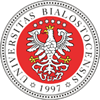Proszę używać tego identyfikatora do cytowań lub wstaw link do tej pozycji:
http://hdl.handle.net/11320/4345| Tytuł: | Zagłada skupisk żydowskich w regionie białostockim w latach 1939, 1941-1944 |
| Inne tytuły: | The Destruction of the Jews in the Białystok Region in the Years 1939 and 1941 to 1944 |
| Autorzy: | Monkiewicz, Waldemar |
| Data wydania: | 1989 |
| Data dodania: | 13-lip-2016 |
| Wydawca: | Dział Wydawnictw Filii UW w Białymstoku |
| Źródło: | Studia Podlaskie T. 2, 1989, s. 336-354 |
| Abstrakt: | The Białystok region is understood here as the area of the pre-War Voivodship, excluding the areas presently within the borders of USSR. The Jewish population in the area before the War amounted to 160 000-190 000. September 1939 brought first material and biological losses to the Jewish population of the Suwałki region. Initially the Red Army entered the region, but it retreated and since October 1939 the Suwalskie was under the German occupation. In November 1939 about 2200 Jewish men, women and children were removed from their homes and driven to the Lithuanian border. After a week of encampment they were accepted by the Lithuanian authorities to their territory. When the Germans entered Lithuania in June 1941, those exiles shared the tragic fate of the Lithuanian Jews. In December another group of 4 000 Jews was relocated to (a part of Poland occupied by Germans known as General Gouvernement) where they perished in extermination actions carried out against Jewish population of these areas. Almost all Jews of Suwałki were killed. Thanks to fortunate circumstances and Polish people's help about 200 Jews survived. Since September 1939 to June 1941 the Białystok region was administered by the Soviet authorities. Immediately after the entry of the German forces to Białystok in June 1941 the Jewish quarters and the synagogue were burnt. About 2000 Jews were killed then. Similar pogroms took place at the same time also in other towns. In August the Germans carried out two mass executions of the Jewish people in Białystok district Pietrasze. In summer 1941 terror reached numerous villages and small towns of the region, where Germans carried out mass executions or burnt people alive. In August 1941 Germans isolated the Ghetto in Białystok, the largest in the region, where about 50 000 people existed. Similar Ghettoes were created in many other places. On November 2, 1941 small Ghettoes were closed down, while their inhabitants were taken to extermination camps. In Białystok the Ghetto went through several phases of gradual destruction (September 1941, February 1943). A group of 300 poorly armed defenders for several weeks attempted resistance. In August 1943 the Ghetto ceased to exist. Jews were taken to extermination camps. Only few small groups of refugees managed to reach armed partisan groups active in the vicinity of the town. All Jewish settlemens in the region were totally destroyed. Only very few Jews managed to survive with the help of Poles, Belorussians or Lithuanians. |
| Opis: | 500 lat osadnictwa żydowskiego na Podlasiu. Materiały z konferencji międzynarodowej, Białystok, 14 - 17 września 1987 r. 500 Years of the Jewish Settlement in Podlasie. Popers From the International Conference, Białystok, September 14 - 17, 1987. |
| URI: | http://hdl.handle.net/11320/4345 |
| ISSN: | 0239-9245 |
| Typ Dokumentu: | Article |
| Występuje w kolekcji(ach): | Studia Podlaskie, 1989, tom II |
Pliki w tej pozycji:
| Plik | Opis | Rozmiar | Format | |
|---|---|---|---|---|
| Studia_Podlaskie_2_Monkiewicz.pdf | 8,02 MB | Adobe PDF | Otwórz |
Pozycja jest chroniona prawem autorskim (Copyright © Wszelkie prawa zastrzeżone)

